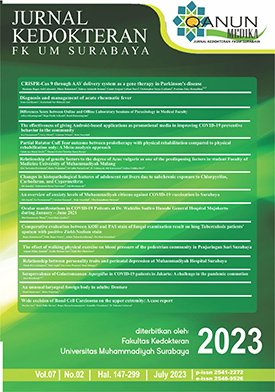Relationship of genetic factors to the degree of Acne vulgaris as one of the predisposing factors in student Faculty of Medicine University of Muhammadiyah Malang
Abstract
Acne vulgaris is a skin disease, a chronic inflammation that affects the poly sebaceous glands, especially on the face and neck. One of the endogenous causes that influence the occurrence of acne vulgaris is a genetic and hormonal predisposition. Family history of acne is one of the risk factors in family genetics associated with the onset of the disease, the difficulty of therapy, and the risk for relapse. This research aimed to explain the relationship between genetic factors to the degree of acne vulgaris as one of the predisposing factors. This research was observational analytic, using purposive sampling as the sampling method and collecting data using a cross-sectional questionnaire. Statistical analysis between variables shows that age was not related (p = 0,790), while gender was not related (p = 0,066), the father's genetic history was related (p = 0,001), and mother's genetic history was not related (p = 0,390). In conclusion, among the factors that were analyzed, the father's genetic history was the only one which has a relationship in aggravating the degree of acne vulgaris.
Full text article
References
Anaba, E. L., & Oaku, I. R. (2021). Adult female acne: A cross-sectional study of diet, family history, body mass index, and premenstrual flare as risk factors and contributors to severity. International Journal of Women’s Dermatology, 7(3). https://doi.org/10.1016/j.ijwd.2020.11.008
Anyachukwu, C., Onyeso, O., & Ezema, C. (2018). Age, Body Mass and Physical Activity Determinants of Facial Acne Severity among Southern Nigerian Adolescents and Young Adults. West Indian Medical Journal. https://doi.org/10.7727/wimj.2017.162
Bansal, P., Sardana, K., Vats, G., Sharma, L., Garga, U., & Khurana, A. (2020). A prospective study examining trigger factors and hormonal abnormalities in adult female acne. Indian Dermatology Online Journal, 11(4). https://doi.org/10.4103/idoj.idoj_500_19
Common, J. E. A., Barker, J. N., & van Steensel, M. A. M. (2019). What does acne genetics teach us about disease pathogenesis? In British Journal of Dermatology (Vol. 181, Issue 4). https://doi.org/10.1111/bjd.17721
Edalatkhah, H., Matin, E., & Ahari, S. S. (2017). Familial risk of acne vulgaris in 8-13 year-old females: A case-control study. Iranian Journal of Dermatology, 20(2).
Ghodsi, S. Z., Orawa, H., & Zouboulis, C. C. (2009).
Prevalence, severity, and severity risk factors of acne in high school pupils: A community-based study. Journal of Investigative Dermatology, 129(9). https://doi.org/10.1038/jid.2009.47
Heng, A. H. S., Say, Y. H., Sio, Y. Y., Ng, Y. T., & Chew, F. T. (2021). Gene variants associated with acne vulgaris presentation and severity: a systematic review and meta-analysis. BMC Medical Genomics, 14(1). https://doi.org/10.1186/s12920-021-00953-8
Melnik, B. C. (2016). Western diet-induced imbalances of FoxO1 and mTORC1 signalling promote the sebofollicular inflammasomopathy acne vulgaris. Experimental Dermatology, 25(2). https://doi.org/10.1111/exd.12898
Šijak, D., Horvat, I., Sonicki, Z., Murat-Sušić, S., Husar, K., Skerlev, M., Marinović, B., & Mokos, Z. B. (2019). Correlation between family history and the age of onset of childhood acne in relation to sex and type of acne. Acta Dermatovenerologica Croatica, 27(2).
Sitohang, I. B. S., Fathan, H., Effendi, E., & Wahid, M. (2019). The susceptibility of pathogens associated with acne vulgaris to antibiotics. Medical Journal of Indonesia, 28(1). https://doi.org/10.13181/mji.v28i1.2735
Yang, J., Yang, H., Xu, A., & He, L. (2020). A Review of Advancement on Influencing Factors of Acne: An Emphasis on Environment Characteristics. In Frontiers in Public Health (Vol. 8). https://doi.org/10.3389/fpubh.2020.00450
Authors
Copyright (c) 2023 Dwi Nurwulan Pravitasari, M. Yuliansyah Aldi Kurniawan

This work is licensed under a Creative Commons Attribution 4.0 International License.

Qanun Medika by FK UM Surabaya is liscence under Lisensi Creative Commons Atribusi 4.0 Internasional.

